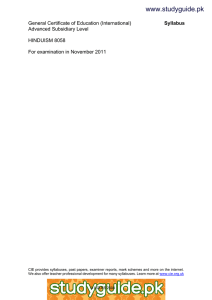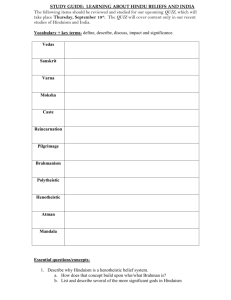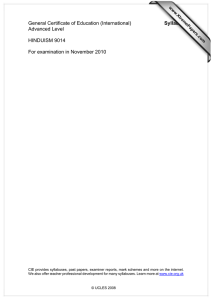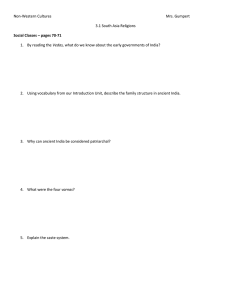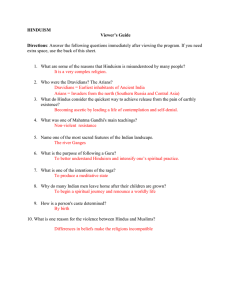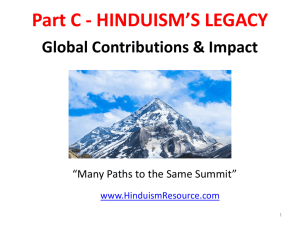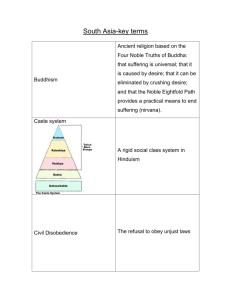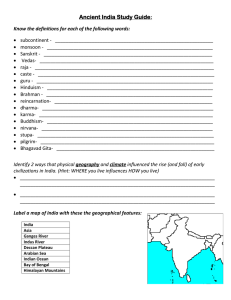www.studyguide.pk
advertisement
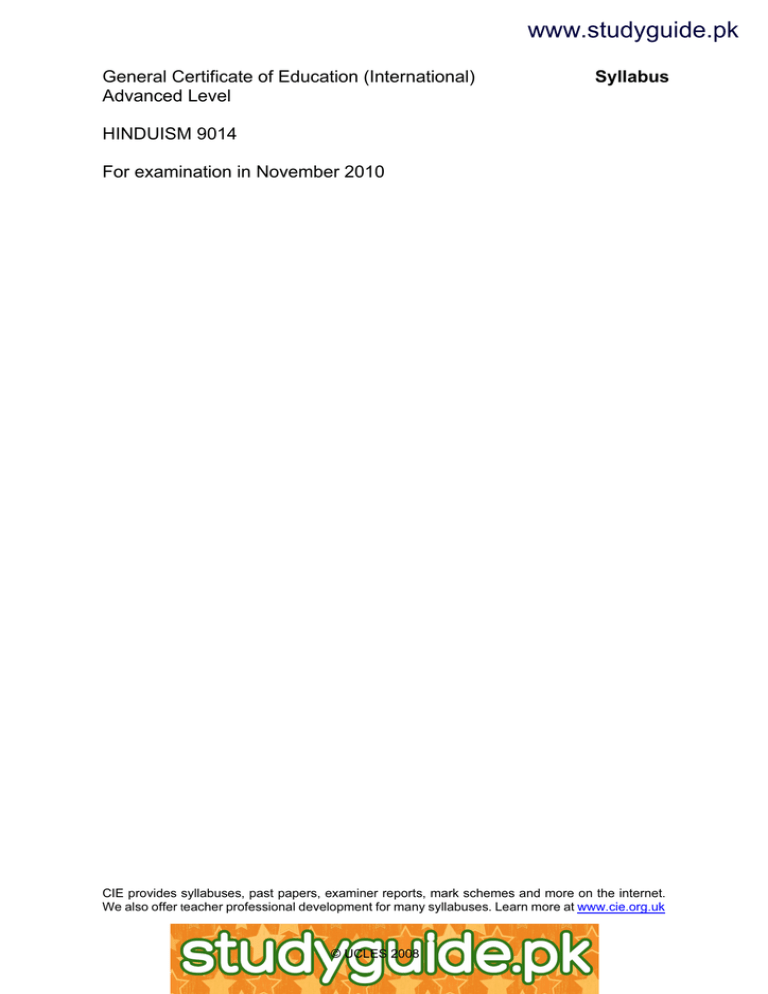
www.studyguide.pk General Certificate of Education (International) Advanced Level Syllabus HINDUISM 9014 For examination in November 2010 CIE provides syllabuses, past papers, examiner reports, mark schemes and more on the internet. We also offer teacher professional development for many syllabuses. Learn more at www.cie.org.uk © UCLES 2008 www.XtremePapers.net www.studyguide.pk www.XtremePapers.net www.studyguide.pk HINDUISM GCE Advanced Level Syllabus 9014 Available in the October/November session only CONTENTS Page AIMS 1 ASSESSMENT OBJECTIVES 1 SCHEME OF ASSESSMENT 1 SYLLABUS CONTENT 2 Exclusions This syllabus must not be offered in the same session with the following syllabus: 8058 Hinduism www.XtremePapers.net www.studyguide.pk 9014 A LEVEL HINDUISM (2010) AIMS The aims of this syllabus are to motivate candidates to develop an enquiring and critical approach to the study of fundamental questions of religious practices, beliefs, morality and interpretations and to explore such issues within the context of a religious tradition or traditions. To realise the above, candidates will be required to gain some understanding of the religious writings, history and current affairs of Hinduism and be able to think and argue intelligently about the subject. ASSESSMENT OBJECTIVES The examination will test the candidate’s: (a) knowledge of the topics and specified texts [60%] (b) understanding of the meaning and significance of the material studied [25%] (c) ability to express himself/herself explicitly, logically and critically in any argument. [15%] SCHEME OF ASSESSMENT The examination will consist of two papers, each of three hours’ duration. Each paper will consist of four sections A, B, C and D; candidates will be required to answer five questions, choosing at least one from each section. At least three questions will be set in each section. Candidates offering Hinduism at Advanced Level (9014) will take Papers 1 and 2. Paper 1 is the same as the Advanced Subsidiary (AS) Level (8058). Results in the AS Level may not be carried over to the A Level. 1 www.XtremePapers.net www.studyguide.pk 9014 A LEVEL HINDUISM (2010) SYLLABUS CONTENT Paper 1 Section A – The Vedic Age The nature of the Vedas as sacred texts, their four major divisions, and their significance within Hinduism. (a) The characteristics, nature and significance of the following Vedic gods: Indra, Varuna, Agni (b) The nature of the Samhitas, with special and detailed reference to the religious ideas of: (i) Purusha Sukta (Rig Veda 10.90) (ii) Nasadiya Sukta (Rig Veda 10.129) (iii) Brahmacarya Sukta (Atharva Veda 11.05) (c) The nature and purpose of the Brahmanas, with special reference to Yajna (d) The nature of the Upanishads, with special reference to: (i) Isa Upanishad (ii) Katha Upanishad. Specified text: The Principal Upanishads by S Radhakrishnan (Allen & Unwin). Section B – The Epic Age The origins of the epics, their nature, the reasons for their popularity. A comparison of some of the themes of the epics: the nature of dharma, the concept of the avatar, the concept of karma, ethical ideals for men and women. These themes will be discussed with special reference to: (a) in the Mahabharata (i) Krishna (iii) Draupadi (ii) (iv) Duryodhana Yudhistira. Specified text: The Bhagavad Gita, chapters 2, 3 and 9 by S Radhakrishnan (Allen & Unwin). (b) in the Ramayana (i) (ii) (iii) (iv) (v) (vi) Rama Sita Lakshmana Bharata Dasaratha Viyoga – Book 3 Rama – Bharata Samvada – Book 4. Specified text: The Ramayana, condensed into English Verse by Romesh C Dutt (Jaico Publishing House, M Gandhi Road, Bombay). This edition is also available online at www.sacred-texts.com/hin/dutt/ Section C – Medieval Age The origins of bhakti movements, with special reference to the Alvars of South India; the importance of bhakti and its relation to other paths to enlightenment. A study of the main achievements, religious and philosophical beliefs of: (a) Surdasa (b) Tulsidasa. 2 www.XtremePapers.net www.studyguide.pk 9014 A LEVEL HINDUISM (2010) Section D – Modern Age Study of the religious, social and political background of the nineteenth and twentieth century reformers of Hinduism. A special study of the main aims, religious and social ideas, and achievements of the following characters: (a) Rammohan Roy (b) Ramakrishna Paramahansa (c) Swami Dayananda (d) M K Gandhi. Paper 2 Section A – Hindu Darshanas A detailed study of the philosophical ideas and spiritual significance of the following: (a) Samkhya – Purusha, Prakriti, Gunas and causation, liberation (b) Yoga – the eight limbs of Yoga, their interrelation; the relation between Yoga and Samkhya (c) Vedanta – (i) Sankara’s Advaita Vedanta (ii) Ramanuja’s Vishista Advaita Vedanta. The relation between the philosophies of Sankara and Ramanuja, with reference to: atman, brahman, bhakti, maya, liberation. Section B – Non-Vedic systems Study of the following religions in relation to Hinduism, their origins and major points of difference and similarity with orthodox Hinduism: (a) Jainism – distinctive teachings about the nature of the human person, knowledge, bondage and liberation, ethics (b) Theravada Buddhism – the life and status of the Buddha, the Four Noble Truths, the Noble Eightfold Path, annica, anatta, karma and rebirth, nirvana and Sangha. Section C – Hindu Devotion and Worship A study of the main forms, images and attributes of the following, their symbolism and significance in the spiritual life of Hindus: Ganesh, Vishnu, Shiva, Durga, Lakshmi, Kartikeya, Hanuman. The relation between the One and the many, and the importance of puja; the role of murtis in worship. Section D – Hindu Ethics A detailed study of the main ideas and significance of the following: (a) the four varnas (b) the four ashramas (c) the purushartas (d) karma and rebirth. 3 www.XtremePapers.net www.studyguide.pk 9014 A LEVEL HINDUISM (2010) Recommended Reading: Paper I S Radhakrishnan S Radhakrishnan Romesh C Dutt S Radhakrishnan Dr Nagendra (ed) Dr Nagendra (ed) K K Lalkarna R N Dandekar David Frawley D S Sharma Raja Gopalachari M Ramnohur V K Subramanian Krishna P Bahadur John Brockington Julius Lipner Rajaram and Frawley Indian Philosophy Vol. I The Principal Upanishads The Ramayana - Condensed into English Verse Jaico Publishing House and available online at www.sacred-texts.com/hin/dutt/ The Bhagavad Gita Tulsidas - His Mind and Art National Publishing House or any other suitable edition Surdas - A Revaluation National Publishing, Darya Ganj, New Delhi Mahatma Gandhi - Contribution to Hinduism Classical Publishing Co., New Delhi Insights into Hinduism Bhandarkar Oriental Research Inst., Poona Wisdom of the Ancient Seers - Mantras of the Rig Veda Motilall Banarasidas, Delhi Hinduism Through the Ages Bharatiya Vidya Bhavan Publications The Ramayana and the Mahabharata Bharatiya Vidya Bhavan Publications Hinduism For All Neeta Prakashan, New Delhi Sacred Songs of India Abhinav Publications The Poems of Surdasa Abhinav Publications The Sacred Thread Edinburgh University Press Hindus: Their Religious Beliefs and Practices Routledge Vedic Aryans and Origins of Civilisation Voice of India Recommended Reading: Paper 2 S Chatterjee and D Datta S Radhakrishnan R N Dandekar H Prabhu M Hiriyana David Kinsley M Ramnohur John Brockington Julius Lipner Rajaram and Frawley An Introduction to Indian Philosophy Calcutta University Press Indian Philosophy - Vols I and II Insights into Hinduism Bhandarkar Oriental Research Institute, Poona Hindu Social Organisation Popular Publication, Bombay Outlines of Indian Philosophy Motilal Banarasidass Hindu Goddesses - Vision of the Divine Feminine in the Hindu Religious Tradition Motilal Banarasidass, Delhi Hinduism For All Neeta Prakashan, New Delhi The Sacred Thread Edinburgh University Press Hindus: Their Religious Beliefs and Practices Routledge Vedic Aryans and Origins of Civilisation Voice of India 4 www.XtremePapers.net
